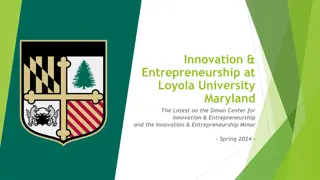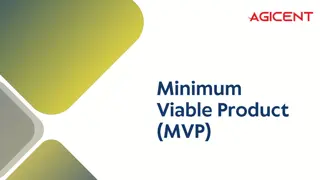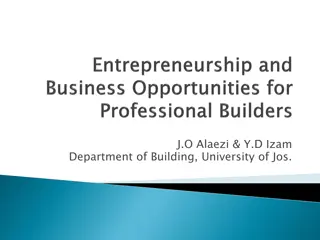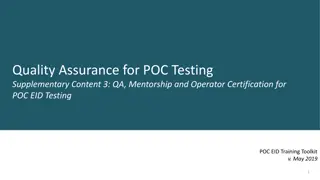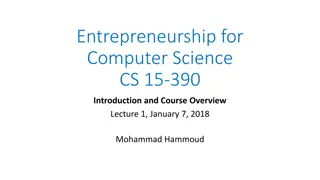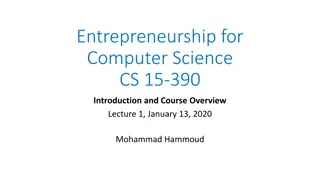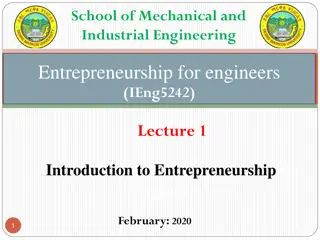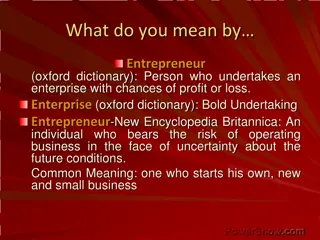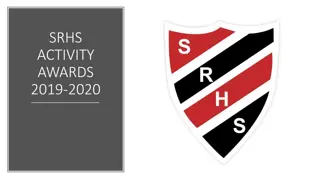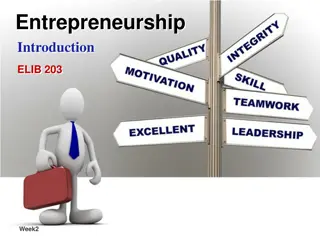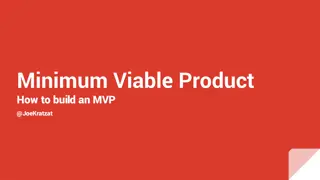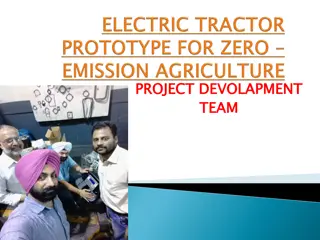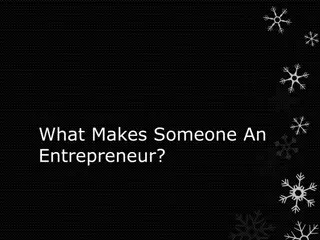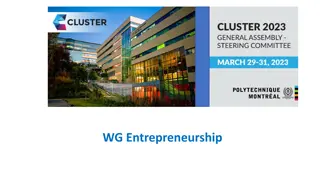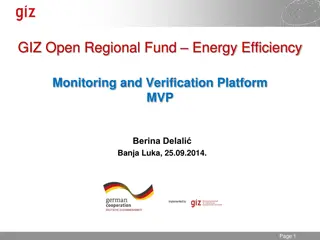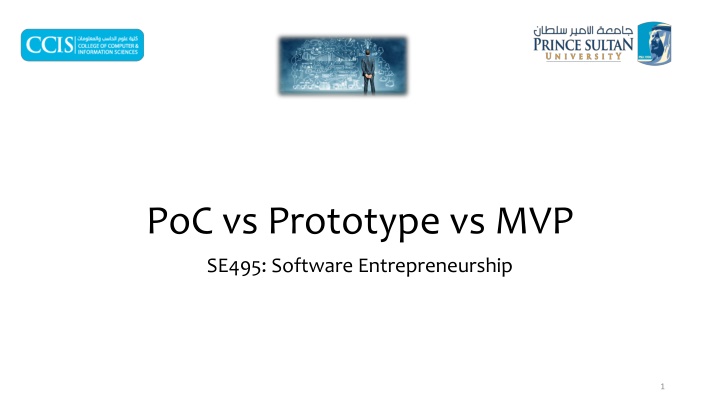
PoC vs Prototype vs MVP in Software Entrepreneurship
Delve into the essential concepts of Proof of Concept, Prototype, and Minimum Viable Product in the realm of software entrepreneurship. Understand their significance in transforming entrepreneurial visions into tangible digital products.
Uploaded on | 1 Views
Download Presentation

Please find below an Image/Link to download the presentation.
The content on the website is provided AS IS for your information and personal use only. It may not be sold, licensed, or shared on other websites without obtaining consent from the author. If you encounter any issues during the download, it is possible that the publisher has removed the file from their server.
You are allowed to download the files provided on this website for personal or commercial use, subject to the condition that they are used lawfully. All files are the property of their respective owners.
The content on the website is provided AS IS for your information and personal use only. It may not be sold, licensed, or shared on other websites without obtaining consent from the author.
E N D
Presentation Transcript
PoC vs Prototype vs MVP SE495: Software Entrepreneurship 1
Outline Overview PoC Prototype MVP PoC vs. Prototype vs. MVP: Major Differences 2
Overview 3
Overview Proof of concept, prototype, and minimum viable product are more than mere industry jargon they re the foundational bricks that anchor any successful digital product. 4
Overview Dive into the world of startups, and you ll soon realize just how crucial these terms become. While each term refers to a different process, they re the guiding lights that help entrepreneurs translate their dreams into reality. 5
Which one does a startup need? A startup typically needs to go through the following progression: PoC - Validate the concept and technology. Prototype - Test and validate key features, user interactions, and overall usability. MVP - Launch a product with just enough features to gather feedback from early adopters and validate the product's value proposition. 6
PoC 7
What is PoC? Proof of concept sounds a little like an arcane term you might hear from a research scientist in a lab, but in the world of startups, it plays an instrumental role. At its core, a PoC is a litmus test for ideas. A PoC seeks to answer a fundamental question: Can this concept work in the practical world? 8
What is PoC? PoC is more of a narrowly focused process. It zeros in on a specific design, project, or assumption and puts it to the test. This PoC process ensures that the seed of an idea can in practice grow into a full-fledged product you can be proud of. 9
How Does a Proof-of-Concept Work? PoC is a small internal project carried out at the discovery stage of your product development project. The creation of PoC involves; Clear business plan to see your project from a different perspective. Simplified introductory design Verify your core idea to address the critical issues, and internal process flows. Outcomes are not meant to be shown to the end users. 10
How Does a Proof-of-Concept Work? The PoC validates your idea s practicality concerning the technical capabilities, resources, and tools. So, if your idea is technically feasible, you can move ahead with the next stage of product development. However, if your idea fails at this stage, PoC helps you save valuable resources, time, and funds in product development. 11
What are the Main Features of PoC? Feasibility Check Idea Exploration Implementing a Small Part Early Detection of Risks and Bugs Cost and Time Saving Simple Outcome 13
PoC Best Practices Clarity of Purpose Set Defined Parameters Gather the Right Team Document Everything Solicit Feedback 14
Why Do You Need to Use a PoC? We ve all heard the statistic that 90% of start-ups fail, and the majority of those failures occur within the early stages. 15
Why Do You Need to Use a PoC? Well-executed PoC can make or break a start-up: Validation Risk Reduction Cost-effective Stakeholder Confidence 16
Examples A startup wants to develop an AI-powered chatbot for customer service. They create a basic PoC that integrates a machine learning model to answer frequently asked questions. The PoC helps the startup validate the concept's potential and assess the technology's capabilities. 17
Examples A startup wants to develop a new mobile app for fitness enthusiasts. They create a PoC that integrates a machine learning model to analyze users' workout data and provide personalized recommendations. The PoC helps the startup validate the concept's potential and assess the technology's capabilities. 18
Examples A startup wants to create a smart home automation system. They build a PoC that connects a few devices, such as lights and thermostats, to a central hub. The PoC helps the startup validate the feasibility of the system and identify potential challenges. 19
Prototype 20
What is a Prototype? While the PoC is considered the initial test for the feasibility of an idea, the prototype is a journey toward creating a product in a more usable form. A prototype is a tangible or visual representation of your product that takes you several steps closer to the real deal. 21
What is a Prototype? Think of a prototype as a draft. It allows teams and stakeholders to visualize and interact with the core functionalities of the product. More than just a sketch, it s the first draft of the product, highlighting the anticipated user experience and journey. 22
How Does Prototyping Work? The development of a prototype starts with a product owner defining objectives and system requirements to create a working solution with a preliminary design. 23
How Does Prototyping Work? Once the initial design is done and the prototype is built, it involves brainstorming of basic representation to identify essential features and functionalities. The form of the prototype depends on your product and the specific features you wish to test and demonstrate. By gathering valuable feedback and insights on your prototype, you can improve your concept, get valuable insights, and make informed decisions for the successful development of your product. 24
Major Prototype Models Throwaway/Rapid Prototyping This is the sprinter of prototypes. Crafted swiftly, it represents specific aspects of interest. It serves its purpose, garners feedback, and then gracefully exits the stage, allowing the actual product to be developed with newfound clarity. 26
Major Prototype Models Evolutionary Prototyping Consider this the long-distance runner. Starting with a basic version, it undergoes numerous iterations. Each round hones the prototype based on invaluable user feedback, gradually sculpting it closer to the final masterpiece. 27
Major Prototype Models Incremental Prototyping This model takes a modular approach. Envision building a product as assembling a puzzle; each prototype is a piece of that puzzle. They're crafted, refined, and perfected individually, eventually coming together to unveil the complete picture. 28
Why Do You Need a Prototype? Prototyping isn't just a buzzworthy phase in product development, it's a critical step that can spell the difference between success and obscurity. 29
Prototyping becomes evident Visualization User Feedback Design and Development Clarification 30
Prototyping Best Practices Incorporate Realistic Content and Interactions Map Out User Journeys Foster Collaborative Design Test Across Devices and Platforms Continuously Test and Iterate 31
Examples Building upon the chatbot example, the startup creates a prototype that incorporates natural language processing (NLP) and integrates with a messaging platform. The prototype allows the startup to test the chatbot's functionality, user experience, and compatibility with different platforms. 32
Examples A startup wants to develop a new e-commerce platform. They create a prototype that includes basic features such as product listing, search, and checkout. The prototype helps the startup test the user experience, identify usability issues, and refine the product's requirements. 33
Examples A startup wants to create a virtual reality game. They build a prototype that includes basic gameplay mechanics, such as movement and interaction with objects. The prototype helps the startup test the game's playability, identify areas for improvement, and iterate on the design. 34
MVP 35
What is an MVP? What do Uber, Dropbox, Slack, and Figma all have in common? It s not just that they re unicorn companies or giants in their respective fields, but also launched their projects with a minimum viable product (MVP). The purpose of an MVP is to assess market and user acceptance, identify favored features, and determine what should be added in later stages of development. 36
MVP An MVP embodies the essence of a product, stripped of all its frills yet functional and potent enough to offer genuine value to early adopters. Key Characteristics of the MVP Functionality Iterative Process Cost Efficiency 37
How Does an MVP Work? Identify a minimal set of features to address the value proposition and solve the problem. Validate hypotheses and gauge demand while satisfying early adopters. Offer a realistic user experience by providing a functional solution with clean code. Prioritize user-generated data and feedback for refinement. Minimal does not mean inferior; it emphasizes value-driven development based on user insights for early adopters to gather and analyze feedback. 39
Why Do You Need an MVP? Early Market Entry Feedback Reduce Wastage 40
Main Characteristics of an MVP Cost-effective Production Core Feature Focus Value-Driven Targeted Audience Iterative development 41
MVP Best Practices Swift MVP Delivery Handling Requirement Volatility Selecting the Right Platform Learning from MVP Setbacks 42
Examples After testing the chatbot prototype, the startup decides to launch an MVP with basic features, such as answering frequently asked questions and directing customers to relevant support pages. The MVP allows the startup to gather feedback from early adopters, identify pain points, and iterate to improve the chatbot's functionality and user experience. 43
Examples A startup wants to develop a new social media platform. They launch an MVP with basic features such as user profiles, news feeds, and messaging. The MVP helps the startup gather feedback from early adopters, identify key features that are missing, and iterate on the product's development. 44
Examples A startup wants to create a new online marketplace for freelancers. They launch an MVP with basic features such as job posting, resume upload, and messaging. The MVP helps the startup gather feedback from early adopters, identify pain points, and iterate on the product's development. 45
PoC vs. Prototype vs. MVP: Major Differences 46
Differences 47
When to Use? You can use a Proof of Concept (PoC) when: Validate your new product idea before any sort of investment. Share internal knowledge about your product idea with team members Secure investment by verifying industrial utility. To ensure your product s industrial utility. To make informed decisions before committing resources. 50

